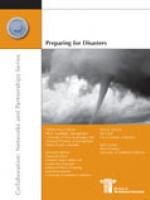
Preparing for Disasters

This report includes two essays reflecting different perspectives on preparing for and working in large-scale emergencies.
The first essay, "Keys to Effectively Partner in Temporary Networks," by Ross O’Brien, examines the roles of nongovernmental organizations in large-scale emergencies. He observed a series of characteristics that helps explain why some aid organizations were more effective emergency responders. Organizations that display these characteristics are more capable of creating and using temporary networks to address a specific emergency event. He offers advice on what both nonprofit and public managers might do to prepare for such networks in advance.
Separately, but similarly, Dr. Richard Callahan and his colleagues Dr. Dan Haverty and Dr. Ross Clayton examine in the second essay, "Emergency Management Networks in California," how the State of California has developed a series of emergency response networks and specific tools for preparing and responding to emergencies, whether the emergencies are forest fires, homeland security events, or public health episodes. California has one of the most developed set of emergency response networks in the country, in part from its history with disasters dating back to the 1906 San Francisco earthquake. A number of innovations, such as the Incident Command System, were developed by California and are now used nationally.
Together, these two essays provide useful insights for both nonprofit and public managers in preparing for potential future disasters. We hope this report will help them be more prepared. Collaboration: Networks and Partnerships



